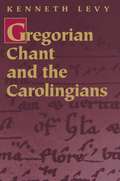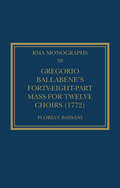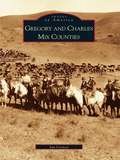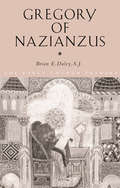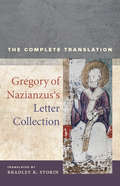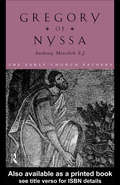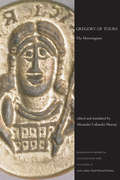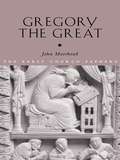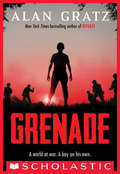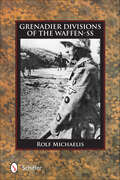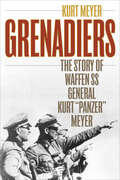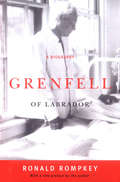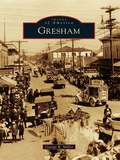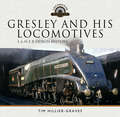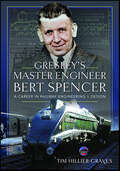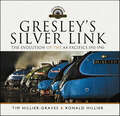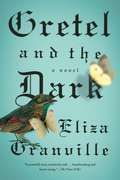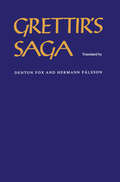- Table View
- List View
Gregorian Chant and the Carolingians
by Kenneth LevyA world-renowned scholar of plainchant, Kenneth Levy has spent a portion of his career investigating the nature and ramifications of this repertory's shift from an oral tradition to the written versions dating to the tenth century. In Gregorian Chant and the Carolingians, which represents the culmination of his research, Levy seeks to change long-held perceptions about certain crucial stages of the evolution and dissemination of the old corpus of plainchant--most notably the assumption that such a large and complex repertory could have become and remained fixed for over a century while still an oral tradition. Levy portrays the promulgation of an authoritative body of plainchant during the reign of Charlemagne by clearly differentiating between actual evidence, hypotheses, and received ideas. How many traditions of oral chant existed before the tenth century? Among the variations noted in written chant, can one point to a single version as being older or more authentic than the others? What precursors might there have been to the notational system used in all the surviving manuscripts, where the notational system seems fully formed and mature? In answering questions that have long vexed many scholars of Gregorian chant's early history, Levy offers fresh explanations of such topics as the origin of Latin neumes, the shifting relationships between memory and early notations, and the puzzling differences among the first surviving neume-species from the tenth century, which have until now impeded a critical restoration of the Carolingian musical forms.
Gregorio Ballabene’s Forty-eight-part Mass for Twelve Choirs (Royal Musical Association Monographs)
by Florian BassaniNeither Spem in alium, the widely acclaimed ‘songe of fortie partes’ by Thomas Tallis, nor Alessandro Striggio’s forty-part Mass is the largest-scale counterpoint work in Western music. The actual winner is Gregorio Ballabene, a relatively unknown Roman maestro di cappella, a contemporary of Giovanni Paisiello, Joseph Haydn and Luigi Boccherini, who composed in forty-eight parts for twelve choirs. His Mass saw only a public rehearsal and was never performed liturgically despite all of Ballabene’s efforts to promote it. On closer inspection, however, the work deserves special consideration as a piece of outstanding combinatory creativity – the product of a talent able to conceive, structure and realise a project of colossal dimensions. It might even be claimed that if Charles Burney had gained knowledge of it, all derogatory comments by nineteenth-century music historians would not have succeeded in extinguishing the interest of later generations. Ballabene’s Mass has remained completely unstudied until today, even though the score survives in prominent collections. This study offers, for the first time, a historical and analytical perspective on this overlooked manifestation of a very individual musical intelligence.
Gregory and Charles Mix Counties
by Jan CerneyIn 1804, Lewis and Clark navigated the Missouri River by keelboat, exploring the river border between the two future counties of Gregory and Charles Mix. Their discovery and exploration of the territory acquired in the Louisiana Purchase unleashed the movement west and its subsequent settlement. The area, first described in exploration journals as rich in vegetation and wildlife, remains a scenic wonder.Since Lewis and Clark's exploration, the area has had its share of interesting history. Using over 200 historic photographs, Gregory and Charles Mix Counties awakens the area's past and highlights some of its most unique attributes.
Gregory of Nazianzus (The Early Church Fathers)
by Brian DaleyThis book brings together a new, original survey of the significance of Gregory's life and work with translations of eight beautiful and profound orations. Gregory of Nazianzus portrays a vivid picture of a fascinating character of vital importance who deserves to be regarded as the first true Christian humanist. The eight orations, each representing a different aspect of his writing, are examined alongside a selection of his shorter poems in verse translation, letters, and a translation of Gregory's own will. Author Brian Daley offers extensive commentary on the works translated and an ample bibliography. With an extensive introduction to Gregory's life, thought and writings, and including detailed notes, this study places Gregory in his correct historical context, and gives students access to a deeper understanding of this fascinating figure from the past.
Gregory of Nazianzus's Letter Collection: The Complete Translation (Christianity in Late Antiquity #7)
by Bradley K. Storin Gregory of NazianzusSaint Gregory of Nazianzus, also known as Gregory the Theologian, lived an illustrious life as an orator, poet, priest, and bishop. Until his death, he wrote scores of letters to friends and colleagues, clergy members and philosophers, teachers of rhetoric and literature, and high-ranking officials at the provincial and imperial levels, many of which are preserved in his self-designed letter collection. Here, for the first time in English, Bradley K. Storin has translated the complete collection, offering readers a fresh view on Gregory’s life, social and cultural engagement, leadership in the church, and literary talents. Accompanying the translation are an introduction, a prosopography, and annotations that situate Gregory’s letters in their biographical, literary, and historical contexts. This translation is an essential resource for scholars and students of late antiquity and early Christianity.
Gregory of Nyssa (The Early Church Fathers)
by Anthony MeredithGregory of Nyssa provides a concise and accessible introduction to the thought of this early church father with new translations of key selections of his writings. Anthony Meredith presents a diverse range of Gregory's writings: his contribution to the debates of the period about the nature of God in argument with a form of extreme Arianism his discussion of the nature and work of the Holy Ghost, against the so-called 'Spirit fighters' his defence of the humanity of Christ against those who denied it (notably Apollinarius) the nature of fate and other philosophical issues.
Gregory of Tours: The Merovingians (Readings In Medieval Civilizations And Cultures Ser. #10)
by Alexander Callander MurrayGeorgius Florentius Gregorius, better known to posterity as Gregory, Bishop of Tours, was born about 538 to a highly distinguished Gallo-Roman family in Clermont in the region of Auvergne. Best known for his 10-book Histories (often called the History of the Franks), Gregory left us detailed accounts of his own times as well as those of the early Merovingian kings, known as the "long-haired kings," who united the Franks and took control of most of Gaul in the late fifth and early sixth century. Although he is one of the most important historians of pre-modern times, the complex, apparently disconnected, elements of Gregory's work are often difficult for today's readers to understand. This selected, new translation is composed of extensive sections from Books II to X and follows in a connected narrative the political events of the Histories from the appearance of the first Merovingian kings, Merovech, Childeric, and Clovis to the last years of the reigns of Guntram and Childebert II in the late sixth century. This book is designed to introduce new readers, and even experienced ones, to the political world (secular and ecclesiastical) of sixth-century Gaul and to provide an up-to-date guide to reading the bishop of Tours' fascinating account of his times. Included in this volume are twenty-one drawings by Jean-Paul Laurens, a nineteenth-century French historical artist and interpreter of the Merovingians.
Gregory the Great (The Early Church Fathers)
by John MoorheadGregory's life culminated in his holding the office of pope (590 - 604). He is generally regarded as one of the outstanding figures in the long line of popes, and by the late ninth century had come to be known as 'the Great'. Along with Ambrose, Jerome and Augustine, he played a critical role in the history of his time, while during the middle ages his intellectual influence was second only to that of Augustine.This volume provides a biographical and intellectual context to Gregory the Great, and new translations of his most influential writings.
Gregory the Great: Perfection in Imperfection
by Carole StrawGregory I (590-604) is often considered the first medieval pope and the first exponent of a truly medieval spirituality. Carole Straw places Gregory in his historical context and considers the many facets of his personality--monk, preacher, and pope--in order to elucidate the structure of his thought and present a unified, thematic interpretation of his spiritual concerns.
Grenada 1983
by Paul Hannon Lee RussellOn 21 October 1983, following the death of Prime Minister Maurice Bishop, the leaders of the six small nations forming the Organization of Eastern Caribbean States voted to intervene militarily to restore order in Grenada. As none possessed the forces necessary to carry out a successful operation, the United States, fearing for its citizens on the island, and wanting to curb Cuba's growing influence, decided to get involved. This book provides a day-by-day account of the US invasion of Grenada, focusing on the units and forces deployed. Numerous contemporary photographs and colour plates detail the uniforms and equipment of the US, Cuban and Caribbean forces.
Grenada: Statistical Appendix
by International Monetary FundA report from the International Monetary Fund.
Grenade
by Alan GratzIt's 1945, and the world is in the grip of war. <P><P>Hideki lives with his family on the island of Okinawa, near Japan. When WWII crashes onto his shores, Hideki is drafted into the Blood and Iron Student Corps to fight for the Japanese army. He is handed a grenade and a set of instructions: Don't come back until you've killed an American soldier. <P><P>Ray, a young American Marine, has just landed on Okinawa. This is Ray's first-ever battle, and he doesn't know what to expect -- or if he'll make it out alive. He just knows that the enemy is everywhere. <P><P>Hideki and Ray each fight their way across the island, surviving heart-pounding ambushes and dangerous traps. But then the two of them collide in the middle of the battle...And choices they make in that single instant will change everything. <P><P>Alan Gratz, New York Times bestselling author of Refugee, returns with this high-octane story of how fear and war tear us apart, but how hope and redemption tie us together. <P><b>A New York Times Bestseller</b>
Grenadier Divisions of the Waffen-SS
by Rolf MichaelisConcise history of all 18 Waffen-SS grenadier divisions in WWII
Grenadiers: The Story of Waffen SS General Kurt "Panzer" Meyer
by Kurt MeyerReprint of the classic World War II memoir German General Kurt "Panzer" Meyer's autobiography is a fascinating insight into the mind of one of Germany's most highly decorated and successful soldiers of World War II. If you love small-unit actions, this is the book for you. Follow Meyer with the 1st SS-Panzer Division "Leibstandarte" and the 12th SS-Panzer Division "Hitlerjugend," from the first day of the war in Poland, through service in France, Russia, and Greece, up until his capture in Normandy in 1944 and his postwar trials and tribulations.
Grendel
by John C. GardnerWhen Grendel is drawn up from the caves under the mere, where he lives with his bloated, inarticulate hag of a mother, into the fresh night air, it is to lay waste Hrothgar's meadhall and heap destruction on the humans he finds there. What else can he do? For he is not like the men who busy themselves with God and love and beauty. He sees the infuriating human rage for order and recognises the meaninglessness of his own existence. GRENDEL is John Gardner's masterpiece; it vividly reinvents the world of Beowulf. In Grendel himself, a creature of grotesque comedy, pain and disillusioned intelligence, Gardner has created the most unforgettable monster in fantasy.
Grenfell of Labrador
by Ronald RompkeyWhen British doctor Wilfred Grenfell arrived in Newfoundland in 1892 to provide medical service to migrant fisherman, he had no clear sense of who his patients were or how they lived - a few weeks on the Labrador coast changed that. Struck by both the rugged beauty of the place and the difficulties faced by those who lived there, Grenfell devoted the rest of his life to improving theirs. At first an evangelical missionary of the Royal National Mission to Deep Sea Fisherman, Grenfell became part of philanthropic movements on both sides of the Atlantic. Raising funds in Canada and the United States, he founded a network of hospitals, nursing stations, schools, and home industries that exists in a modified form to this day. In 1908, the story of his survival after a night marooned on a drifting patch of ice transformed him into a popular hero. He eventually became one of the most successful lecturers of his time. Ronald Rompkey tells the story of Grenfell's education, his Anglo-Saxonism, and his devotion to broader issues of hygiene and public health. Above all, Rompkey shows that Grenfell went beyond being a doctor or a missionary to become a cultural politician who intervened in a colonial culture. Grenfell of Labrador provides a vivid picture of the man himself and the social movements through which he worked.
Gresham
by George R. MillerThe history of Gresham, Oregon, is rooted in the pioneers who trekked along the Oregon Trail in the 1800s. Traveling down the Columbia River or over the precipitous route by scenic Mount Hood, they arrived in what was then called Powell Valley, so named by the first settlers. They found trees that were unparalleled, tall, and straight, which they used to build their first communities. The rich, fertile land was cleared to grow an array of crops that would eventually make the area well known for its agriculture.
Gresley and His Locomotives: L & N E R Design History
by Tim Hillier-GravesAn in-depth look at the team who worked with the renowned British railway engineer, with numerous photos included.To renowned engineer Nigel Gresley must go great credit for many of the London and North Eastern Railway’s achievements, but those around him have faded into obscurity and are now largely forgotten, even though their contributions were immense. To redress this imbalance, Tim Hillier-Graves has explored the life of Gresley and his team, and sought to uncover a more expansive picture of these events. This in no way diminishes Gresley’s stunning accomplishments—but builds a fuller and more authentic view of a dynamic period in railway history.The book draws upon many sources of information, some of it previously unpublished, to present a fascinating picture of all that happened and all that was achieved, often in the most difficult of circumstances, by a very gifted team of engineers and their exceptional leader.
Gresley and His Locomotives: L & N E R Design History (Locomotive Portfolios Ser.)
by Tim Hillier-GravesAn in-depth look at the team who worked with the renowned British railway engineer, with numerous photos included.To renowned engineer Nigel Gresley must go great credit for many of the London and North Eastern Railway’s achievements, but those around him have faded into obscurity and are now largely forgotten, even though their contributions were immense. To redress this imbalance, Tim Hillier-Graves has explored the life of Gresley and his team, and sought to uncover a more expansive picture of these events. This in no way diminishes Gresley’s stunning accomplishments—but builds a fuller and more authentic view of a dynamic period in railway history.The book draws upon many sources of information, some of it previously unpublished, to present a fascinating picture of all that happened and all that was achieved, often in the most difficult of circumstances, by a very gifted team of engineers and their exceptional leader.
Gresley's Master Engineer, Bert Spencer: A Career in Railway Engineering and Design
by Tim Hillier-GravesThe great and the good rarely, if ever, accomplish all they wish to achieve without the able assistance of many skilled men and women. To have a very capable person beside you acting as guide, confidant and adviser is essential. Even better when it is someone with a depth of knowledge equal to, or even better than your own. If all these skills can be combined in one trusted, assistant so much the better. To a leader such a person may be valued ‘beyond rubies’, because they have the ability to take ideas, add something and help make them a reality. For Herbert Nigel Gresley, CME of the LNER, Bert Spencer was just such a man. As Gresley triumphed his faithful, introverted and highly talented assistant remained resolutely in the background playing an unsung yet key role in the development of Gresley’s outstanding Pacifics and his many other memorable locomotives. For sixteen vibrant years Spencer sat beside his greatly admired leader witnessing and participating in all that happened adding much to an emerging legend that still resounds with us today. Here, for the first time, is Spencer’s fascinating story, much of it in his own words. This was made possible by the thoughts and memories he recorded in letters to friends, papers he wrote for the Institution of Locomotive Engineers, official documents and much more. All this has been edited together to produce a unique and important personal narrative of his life and work.
Gresley's Silver Link: The Evolution of the A4 Pacifics 1911–1941 (Locomotive Portfolios)
by Tim Hillier-Graves Ronald HillierGresley’s A4 Pacifics are arguably the most famous locomotives ever built, a status cemented by Mallard’s record breaking run on the 3rd July ‘38. And yet only a year later the glamorous ‘streaks’ seemed likely to be cast into obscurity by the coming of another world war. So, for only four exhilarating years they were allowed to flourish as their creator had intended and in that time captured the imagination of railwaymen and public alike. With the help of previously unpublished material the author analyses the complex evolution of the A4s - a project that began in 1911 when Gresley was appointed as Locomotive Superintendent of the Great Northern Railway. It is a story with many strands to consider – war, peace and war again, engineering and art, politics and business, recession and social change, the growth of the media and consumerism, the struggle for professional reputations and a growing, deeply damaging international rivalry. All these elements are captured in the story of the A4s in the heady days before conflict ended their brief golden age and Gresley’s life came to an end.
Gretel and the Dark
by Eliza GranvilleA captivating and atmospheric historical novel about a young girl in Nazi Germany, a psychoanalyst in fin-de-siècle Vienna, and the powerful mystery that links them together. Gretel and the Dark explores good and evil, hope and despair, showing how the primal thrills and horrors of the stories we learn as children can illuminate the darkest moments in history, in two rich, intertwining narratives that come together to form one exhilarating, page-turning read. In 1899 Vienna, celebrated psychoanalyst Josef Breuer is about to encounter his strangest case yet: a mysterious, beautiful woman who claims to have no name, no feelings--to be, in fact, a machine. Intrigued, he tries to fathom the roots of her disturbance. Years later, in Nazi-controlled Germany, Krysta plays alone while her papa works in the menacingly strange infirmary next door. Young, innocent, and fiercely stubborn, she retreats into a world of fairy tales, unable to see the danger closing in around her. When everything changes and the real world becomes as frightening as any of her stories, Krysta finds that her imagination holds powers beyond what she could ever have guessed. Rich, compelling, and propulsively building to a dizzying final twist, Gretel and the Dark is a testament to the lifesaving power of the imagination and a mesmerizingly original story of redemption.
Grettir's Saga
by Hermann Palsson Denton FoxProfound and intriguing, Grettir's Saga is the last of the great Icelandic sagas. It tells of the life and death of Grettir, a great rebel, individualist, and romantic hero viewed unromantically. Grettir spends his childhood violently defying authority: as a youth of sixteen he kills a man and is outlawed; all the rest of his life he devotes, with remarkable composure, to fighting more and more formidable enemies. He pits himself against bears, berserks, wraiths, trolls, and finally, it seems, the whole population of Iceland. Yet he is not a bloodthirsty killer, but only a man who is totally unwilling to compromise. As a result of his desire for freedom, he becomes increasingly isolated, although he wishes to live in society, and indeed can hardly bear solitude. Driven back and forth from Iceland to Norway, harried around Iceland, he continually flees subjection and confinement only to find a perilous freedom beset both by the external hazards of a new land and by the internal hazards of loneliness and pride. He escapes to freedom and finds destruction. He finally meets his death in his last refuge on the top of an unscalable island near the northern tip of Iceland.Grettir's Saga has several themes. One of them is the conflict between the Christian world and the survival of the pagan world, as sorcery or heroic pride; the other is the conflict between man's desire for individual freedom and the restrictive bond imposed by society.This translation is the first into English since 1914; it is based on a more accurate Icelandic text than the earlier translations, and, unlike them, is unexpurgated and in unarchaic English. The saga has an especial modern relevance - a recent translation into Czech reached the top of the best-seller list. The present volume includes genealogies, a study of the legal system, and a critical assessment of the work.
Gretzky to Lemieux: The Story of the 1987 Canada Cup
by Ed WillesGretzky, Lemieux, Messier, Coffey, Fuhr, all on the same team -- in their prime. The greatest collection of hockey talent ever assembled, playing the games of their lives.Three epic 6-5 contests between Canada and the Soviet Union decided the '87 Canada Cup.Canada evened the series, after the Soviets won Game 1, when Gretzky's fifth assist of the game set up Lemieux's hat trick, ending Game 2 in double overtime. Game 2 is widely considered one of the greatest hockey games ever played.With time running out in Game 3, after Canada battled back from a 3-0 deficit, Team Canada coach Mike Keenan sent the Gretzky / Lemieux / Hawerchuk line on the ice for a faceoff in Canada's end. The rest is history as Gretzky, Lemieux, and Larry Murphy rushed up the ice, Gretzky skating on the left wing, setting up Lemieux's game-winner in the slot with 1:26 left in the game. Gretzky's pass to Lemieux, followed by Lemieux's goal, is one of the most memorable plays in hockey history.Gretzky to Lemieux captures the on-ice drama that led to the historic three-game final, and the stories behind it. Ed Willes adds depth and weight to the games by revealing the rebellion among Soviet hockey stars in the early days of Glasnost and a crumbling Soviet Union; the trouble brewing for Alan Eagleson; the ascendancy of Mario Lemieux; and the end of the glorious Gretzky era in Edmonton.Packed with interviews of players and coaches, Gretzky to Lemieux tells the full story of the greatest hockey ever played.From the Hardcover edition.
Grey Bees
by Andrey KurkovUkraine's most famous novelist dramatises the conflict raging in his country through the adventures of a mild-mannered beekeeper. From the author of the bestselling Death and the Penguin."A latter-day Bulgakov . . . A Ukrainian Murakami" - Phoebe Taplin, GuardianLittle Starhorodivka, a village of three streets, lies in Ukraine's Grey Zone, the no-man's-land between loyalist and separatist forces. Thanks to the lukewarm war of sporadic violence and constant propaganda that has been dragging on for years, only two residents remain: retired safety inspector turned beekeeper Sergey Sergeyich and Pashka, a "frenemy" from his schooldays.With little food and no electricity, under ever-present threat of bombardment, Sergeyich's one remaining pleasure is his bees. As spring approaches, he knows he must take them far from the Grey Zone so they can collect their pollen in peace. This simple mission on their behalf introduces him to combatants and civilians on both sides of the battle lines: loyalists, separatists, Russian occupiers and Crimean Tatars. Wherever he goes, Sergeyich's childlike simplicity and strong moral compass disarm everyone he meets. But could these qualities be manipulated to serve an unworthy cause, spelling disaster for him, his bees and his country?Grey Bees is as timely as the author's Ukraine Diaries were in 2014, but treats the unfolding crisis in a more imaginative way, with a pinch of Kurkov's signature humour. Who better than Ukraine's most famous novelist - who writes in Russian - to illuminate and present a balanced portrait of this most bewildering of modern conflicts?Translated from the Russian by Boris Dralyuk
